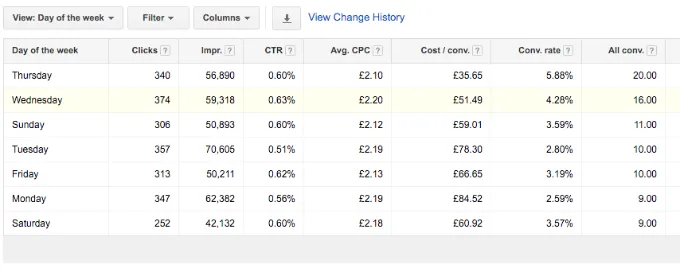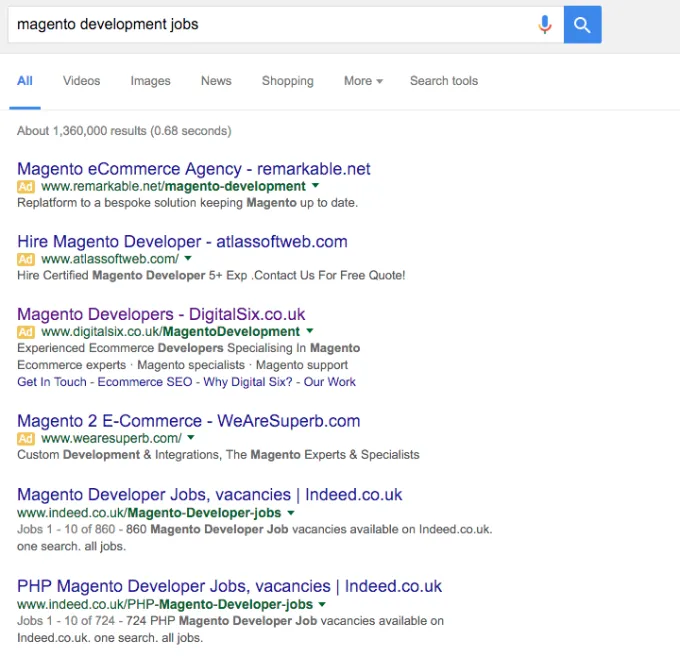read
They’ll add and delete widgets, include maps, muck about with the local business pack and product listing ads. With Google’s success dependent on the quality of search results, of course they’ll work to do everything they can to make sure those returns are as useful as possible.
The last significant improvement, rolled out around 22th of February, and arguably the most important upgrade of the last couple of years has seen the 11 ad slots previously displayed on the main search return page reduced to only 7.
Naturally you’d have thought that less ad space means more competition and higher prices – but does it? Could this in fact be an opportunity? Your chance to capture some better placed Google real estate at better prices while your competition snoozes.
Why the new layout could be good news for your business
First things first, it might not be.
Once above the fold your ads will now be appearing below it and subsequently receiving only fraction of the interest that they previously enjoyed.
That said, if your campaign was precisely targeted you were probably dissatisfied with the amount of clicks you got positioned 5th or lower anyway.
And if you were happy with the results you were probably benefiting more from luck than judgement. That luck having just run out with the new changes.
Fear not though. What at face value might seem bad for you and your budgets is turnaroundable. In fact, there are ways to make your campaign work even better than it was before.
Let’s look at the scenarios:
Say you already advertised on the 1st to 3rd position before the changes. In which case – you win. Whereas previously there were 9-11 links above the fold, now there are only 4. Your ads will be getting much more attention. And your visitor numbers will have risen accordingly.
If you used to advertise on the 4th position before the changes again, congratulations, you are a winner. With the new ad position now appearing on the left instead of top left your ad receives much more attention. A massive 30-50% increase on CTR for the relocated 4th position ads.
In our opinion anyone serious about their paid search will have avoided those 8th to 11th position anyway. After all, as you may well recall, for many queries the last positions were filled with automated ads, for example ‘Find X on Y’ where X was the keyword and Y was another search engine which was based on Google. There was rarely, if ever a good reason for anyone to click there.
What to do if your revenue is down after the change?
If you’re seeing a decline in revenue through Google Adwords than in all likelihood your ads were around 5th to 8th position.
5th to 8th will secure you about 2-3% of the searches. You probably haven’t used any advanced settings within Google Adwords and chances are your negative keyword list is very short.
The big question here is; how can you restore your traffic without paying too much for it?
Let’s do the maths.
Suppose you get 100.000 impressions a month. That 2-3% CTR equated to 2,000-3,000 site visitors. Suppose your average CPC is £1 and suppose too that this gives you a decent return on your investment.
To move up to 4th position you will have to pay around 20% more for a click. A 20% cost increase but a cost increase that yields a CTR of 7-8%. Clearly what matters now is identifying a subset of your visitors where the %age increase in CPC still delivers your required ROI. For example, where your target ROI is 6 it’s important to create a group that delivers at least an ROI of at least 7 to allow for the the increased cost per click.
Do you bid differently for different days of the week?
Here’s another way to get more for your money. Recognising the best times to advertise. As you can see the advertiser below pays twice much for a lead on a Monday or Tuesday than for a lead on a Thursday. By decreasing Monday and Tuesday bids (or even stopping the campaign altogether on these days) he can save more than 20%.

Do you have correct Location settings?
The same advertiser is also losing money by not identifying the most profitable location settings. He paid 50% more (£79 instead of £52) for leads from ‘location of interest’ visitors rather than ‘physical location’ visitors. Money he could have targeted at attracting more visitors from the right location – more physical location visitors.

Negative keyword settings – do you have them set up correctly?
Negative keywords matter. They matter big time. In fact, getting your negative keywords right has arguably the single biggest impact on your ROI.
For example. A keyword term such as ‘magento development jobs’. If you’ve ever used that term you were probably job hunting. Afterall it’s only job seekers who use a search term like that.
So ask yourself, if that’s the case, then how come agencies are getting their Magento development clients to hand over hard earned cash by using the term to attract prospects for their development work when all they’ll end up with is job seekers. Madness.

How can you leverage without paying a fortune?
Back to our original equation.
| Old version | New version | |
|---|---|---|
| Position | 5th – 7th position | At least 4th position |
| Impressions | 100.000 | 50.000- 60.000 |
| CTR | 2-3% | 7-8% |
| Avg CPC | £1 | £1.2 |
| Conversion Rate | 3.69% | 4.79% (projected) |
| CPA | £27 | £25 |
| No. of conversions | Min. 73 | Min. 167* |
* (please note this is dummy data for the purposes of highlighting the issues being discussed, the data above that doesn’t refer to actual campaign performance)
As you can see from the data above it’s very easy to find a subset (all campaigns usually have a viable subset) where you pay much less for a lead and you have enough room to catch the 4th position while the CPA and number of conversions stay the same or improve.
And we haven’t even talked about:
different bidding strategies for mobile and desktop
landing page optimization and A/B landing page tests
ad extensions
There’s nothing unusual about the campaign above. It’s pretty typical of what we come across. And the benefits that we can apply are typical too. Benefits that other agencies simply fail to identify, let alone deliver.
So even if your revenue has declined, we firmly believe that rather than blaming Google for their changes all they’ve really done is reveal that fact that your campaign hasn’t been set up properly.
Time to wave bye bye to existing campaign managers?
Time to say hello to a team who’ll get you making the money you should be making?
It’s never too late.


